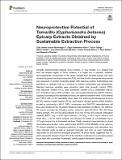Por favor, use este identificador para citar o enlazar a este item:
http://hdl.handle.net/10261/263270COMPARTIR / EXPORTAR:
 SHARE SHARE
 CORE
BASE CORE
BASE
|
|
| Visualizar otros formatos: MARC | Dublin Core | RDF | ORE | MODS | METS | DIDL | DATACITE | |

| Título: | Neuroprotective potential of tamarillo (Cyphomandra betacea) epicarp extracts obtained by sustainable extraction process |
Autor: | Suárez Montenegro, Zully J. CSIC ORCID; Ballesteros-Vivas, Diego; Gallego, Rocío CSIC ORCID; Valdés, Alberto CSIC ORCID; Sánchez-Martínez, J. David CSIC ORCID; Parada-Alfonso, Fabián; Ibáñez, Elena CSIC ORCID ; Cifuentes, Alejandro CSIC ORCID | Palabras clave: | Neuroprotective activity Polyphenol extracts Alzheimer’s disease Pressurized liquid extraction Cyphomandra betacea Green extraction Tropical fruit by-product |
Fecha de publicación: | 2021 | Editor: | Frontiers Media | Citación: | Frontiers in Nutrition 8: 769617 (2021) | Resumen: | Tamarillo (Cyphomandra betacea (Cav.) Sendt.), or tree tomato, is a tropical fruit from the Andean region of South America; it is highly rich in vitamins, minerals, and polyphenolic compounds. In this study, extracts from tamarillo epicarp (TE) were obtained by pressurized liquid extraction (PLE), and their in-vitro neuroprotective potential was assessed. A central composite design with response surface methodology was performed to optimize PLE as a function of solvent composition and temperature. Selected response variables were extraction yield, total phenolic content (TPC), total flavonoid content (TFC), total carotenoid content (TCC), antioxidant (ABTS), and anti-inflammatory (LOX) activities, and anti-acetylcholinesterase (AChE) inhibitory capacity. According to the desirability function, the optimal conditions were 100% ethanol and 180°C with a 0.87 desirability value. Next, the anti-butyrylcholinesterase enzyme (BChE), reactive oxygen species (ROS), and reactive nitrogen species (RNS) inhibition as well as cytotoxicity in HK-2, THP-1 monocytes, and SH-5YSY neuroblastoma cell lines were studied for the TE extract obtained under optimized conditions. The optimum TE extract provided the following results: extraction yield (36.25%), TPC (92.09 mg GAE/g extract), TFC (4.4 mg QE/g extract), TCC (107.15 mg CE/g extract), antioxidant capacity (ABTS, IC50 = 6.33 mg/ml extract), LOX (IC50 = 48.3 mg/ml extract), and AChE (IC50 = 97.46 mg/ml extract), and showed no toxicity at concentration up to 120 μg/ml extract for all the tested cell lines. Finally, chemical characterization by liquid chromatography-tandem mass spectrometry (UHPLC-q-TOF-MS/MS) of the optimum TE extract exhibited an important presence of hydroxycinnamic acid derivatives and other phenolic acids as well as quercetin hexoside and rutin, as main metabolites responsible for the observed biological properties. All these results suggested that TE, which represents between 8 and 15% of the total fruit, could become a promising natural by-product with a potential “multitarget” activity against Alzheimer's disease. | Versión del editor: | https://doi.org/10.3389/fnut.2021.769617 | URI: | http://hdl.handle.net/10261/263270 | DOI: | 10.3389/fnut.2021.769617 | E-ISSN: | 2296-861X |
| Aparece en las colecciones: | (CIAL) Artículos |
Ficheros en este ítem:
| Fichero | Descripción | Tamaño | Formato | |
|---|---|---|---|---|
| neuroprocess.pdf | 2,04 MB | Adobe PDF |  Visualizar/Abrir |
CORE Recommender
SCOPUSTM
Citations
12
checked on 17-may-2024
WEB OF SCIENCETM
Citations
8
checked on 17-feb-2024
Page view(s)
39
checked on 19-may-2024
Download(s)
65
checked on 19-may-2024
Google ScholarTM
Check
Altmetric
Altmetric
Este item está licenciado bajo una Licencia Creative Commons

